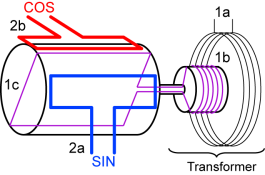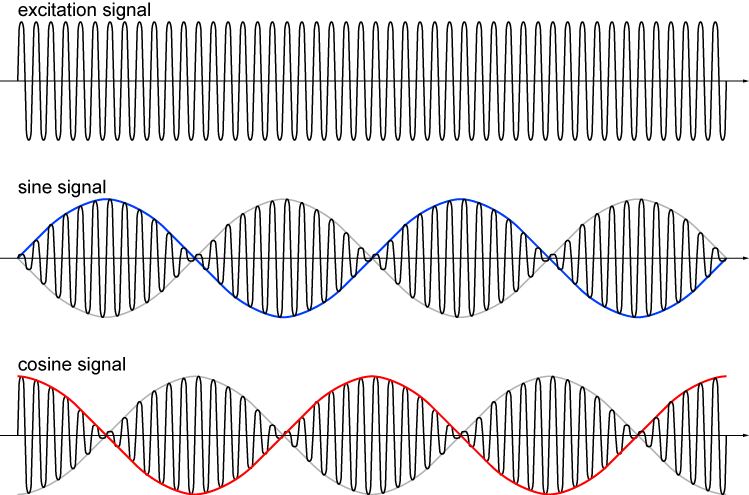Resolver
The resolver is an inductive rotatory position encoder. It supplies an absolute position signal within a rotation (1 SIN/COS period/rotation).
The resolver contains the following windings:
- Exciter winding (stator)
- Secondary winding, connected with the rotor winding (rotor)
- Measurement winding 1 (SIN) and 2 (COS), offset by 90° electrically arranged (stator)

|
Rotary transformer |
||
|
1a |
Exciter winding |
||
|
1b |
Secondary winding | ||
|
1c |
Rotor winding |
||
|
Measurement windings |
|||
|
2a |
Measurement winding 1 SIN track |
||
|
2b |
Measurement winding 2 COS track |
||
The evaluation electronics energize the exciter winding with a high-frequency exciter signal. This signal is transmitted to the secondary winding in the rotor through the rotary transformer. The rotor is connected to the motor shaft. The secondary winding feeds the short-circuited rotor winding, through which a short-circuit current flows with the frequency of the exciter signal. This short-circuit current is surrounded by a magnetic field, which induces voltage in the measurement windings 1 and 2. This induced voltage has the same frequency and phasing as the exciter signal. The amplitudes of the voltages induced in the measurement windings are dependent on the position of the rotor:
- If the rotor and measurement winding are parallel to each other, the magnetic field of the rotor pushes through the measurement winding completely, and the induced voltage amplitude is at a maximum.
- If the rotor and measurement winding are perpendicular to each other, no voltage is induced in the measurement winding.
The amplitude of the induced voltage in each measurement winding is a sine function dependent on the position of the rotor shaft.
The position of the rotor cannot be uniquely determined with a single sine signal. Two sensors, electrically offset by 90° are used that generate a sine and a cosine signal. Through evaluation of both signals, the rotor position and direction of rotation can be uniquely determined.
The signal of the measurement windings consists of the exciter signal with a superimposed envelope. The envelope must be extracted from the evaluation electronics and supplies the position signal.

